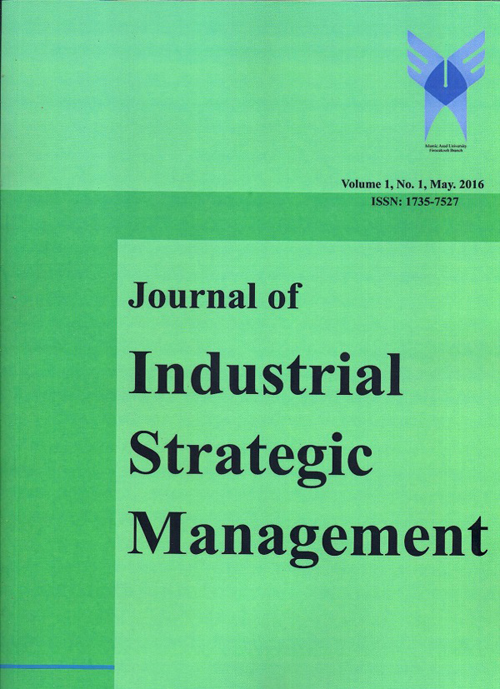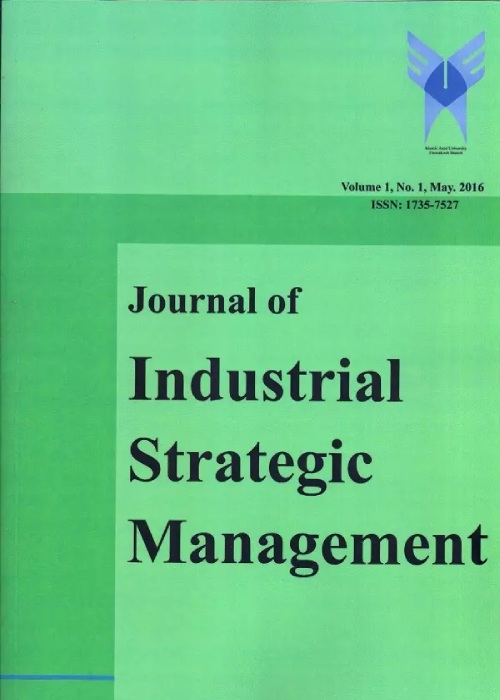فهرست مطالب

Journal of Industrial Strategic Management
Volume:1 Issue: 3, Autumn 2016
- تاریخ انتشار: 1395/09/01
- تعداد عناوین: 7
-
Pages 1-10The classification of fuzzy uncertain data is considered one of the most challenging issues in data analysis. In spite of the significance of fuzzy data in mathematical programming, the development of the analytical methods of fuzzy data is slow. Therefore, the current study proposes a new fuzzy data classification method based on fuzzy data envelopment analysis (DEA) which can handle streaming data.The new method is tested by simulated data and the results indicate its effectiveness in facing uncertain data and variable conditions.Keywords: Fuzzy Data Envelopment Analysis, Mathematical Programming, Classification, Fuzzy Streaming Data
-
Pages 11-20Supply chains are constantly exposed to various risks. An incident or uncertain event, which has positive or negative effect on the objectives of a project, is called a risk. According to this identification, analysis and prioritization of risks may have a significant role in the success of the project. The purpose of risk management is to reduce the risks of non-achievement of these objectives and to identify and benefit from opportunities. Accordingly, the objective of this study is to prioritize the performance of supply chain risks. For this purpose we have analyzed the supply chain of a large automotive part's supplier based on the method of fuzzy analytic network process and taking into account the opinion of specialists and experts. Fields of study for the prioritization of the supply chain risks, consist of five main components: supplier risk, manufacturer risk, distributor risk, external risk and final customer risks. In order to prioritize these fields, questionnaires were prepared and codified based on expert's opinions. Afterwards, the compiled data were analyzed and investigated in Super Decision Software. The research results indicate that among the main components, external risks have the first priority and final customer risks have the second priority. Among the sub-components, the inappropriate price sub-component has the highest rank while the supplier bankruptcy sub-component has the last priority.Keywords: Supply chain, risk, Risk management, Fuzzy Analytic Network Process(FANP)
-
Pages 21-28In recent years, companies have integrated their customer relationship management (CRM) and knowledge management (KM) efforts because they realize that KM plays a key role in CRM success. Both knowledge management (KM) and customer relationship management emphasize the allocation of resources to business supportive activities to gain competitive advantages. The aim of this study is to investigate the correlation between knowledge management strategies and customer relationship management (CRM) in the Iranina hotel chains. The statistical population of the study consists of 220 managers and the size of the sample is 140. Spearman correlation coefficient is used to test the research hypotheses. Our findings show that there is a significant positive relationship between knowledge management strategies and customer relationship management in the Iranian hotel chians.Keywords: Knowledge Management, strategies, customer relationship management, hotel chains
-
Pages 29-38Teleworking is one of the new methods applied in most developed countries to increase organizational flexibility, reduce costs and improve performance. However, the implementation of teleworking is not so successful in Iran. Therfore, the objective of the present study is to identify the factors causing failure in implementation of teleworking. The study is carried out in the governmental agencies in Iran. The study is qualitative. The data was collected through interview and was then analyzed using Coding Method. The findings indicated that 15 concepts in 5 categories prevent the successful implementation of teleworking in government agencies in Iran. Finally, based on the findings, suggestions and recommendations were made for the mangers responsible for telwroking.Keywords: Teleworking, failure, Factors, qualitative approach, Open Coding
-
Pages 39-54Today, information networks play an important role in supply chain management. Therefore, in this article, clustering-based routing protocols, which are one of the most important ways to reduce energy consumption in wireless sensor networks, are used to optimize the supply chain informational cloud network. Accordingly, first, a clustering protocol is presented using self-organizing map neural network, SOM. Second, we cluster the network nodes based on two criteria of neighborhood and energy level using K-means clustering pattern. Third, we survey the efficiency and inefficiency of the clusters to balance the energy properly among the clusters. Then, to increase the network lifetime and to maintain the network DEA method is used. Finally, the model is tested for the information network of oil supply chain.Keywords: Strategy, Neural Network, Energy, Clustering, DEA
-
Pages 55-70Nowadays stakeholders and public awareness have increased the pressure on companies for environmental issues. Thus, green supply chain management (GSCM) seems vital for companie's environmental compliance and business growth. Companies continuously seek novel ideas and methods, that can enable them to obtain and/or maintain environmental sustainability. Greening the supply chain is one such innovative idea that rapidly spreads in the industry. The traditional internal measures, such as performing waste-reduction strategies, installing pollution control technologies, substituting hazardous-materials with environmentally friendly ones, are becoming less important as companies strive to find more innovative solutions. Accordingly, the main objective of the present study is to find interrelationship among green supplier criteria. For this to happen, we investigated expert's opinions through nominal group technique (NGT) to find out the interrelationship and causal preferences of the green supplier evaluation aspects using Decision-Making Trial and Evaluation Laboratory (DEMATEL) method. A numerical example demonstrates the application of the proposed model.Keywords: Green supply chain management, Decision-Making Trial, Evaluation Laboratory (DEMATEL)
-
Pages 71-82Retailers brands maker with private label have significantly boosted market share in recent years. Creating new brands for goods or services provide differentiation with similar distributors. The main aim of this paper is to test which component can be more effective in consumers purchase intention based on using private label for goods image. This research data was collected by prior studies and a designed questionnaire. Our statistical population consists of customers and consumers of Hyperstar store in west of Tehran, Iran. The sample size of this study was determined by Cochran formula (n=196), which 200 questionnaire was distributed among the customers. Designed hypothesis tests were performed using Student's t-statistic as implemented in SPSS software. The results of this study indicate that service quality, perceived risk and price consciousness of the customer have not significant influenceon purchase intention. Furthermore, the effect of these elements on purchase intention is also rejected.Keywords: Private label goods image, store image, Service quality, Perceived risk, Price consciousness, Purchase intention


